Unmanned Perspectives on US Naval Aviation
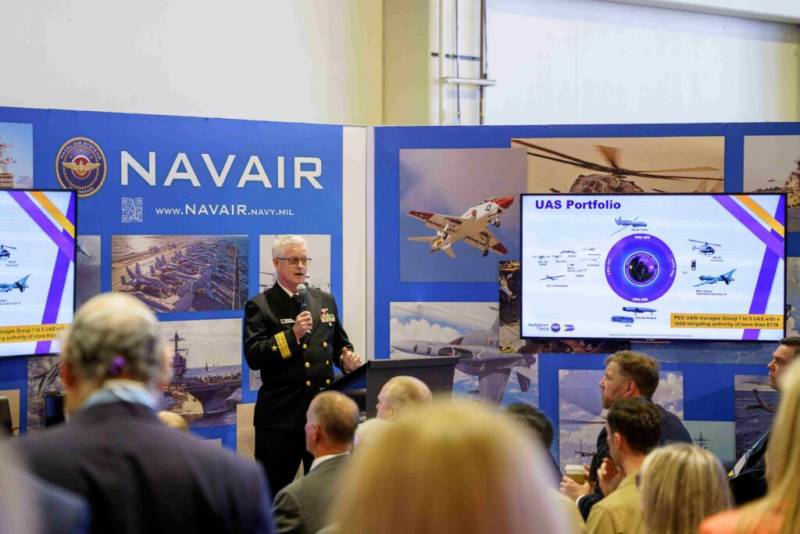
Rear Admiral Stephen Tedford giving a talk at Sea-Air-Space 2023
For a long time, the US Navy has been actively engaged in research in the field of unmanned aviation. In the near future, developments on this topic should reach practical application and affect naval aviation, giving it new opportunities and improving its overall potential. Recently, the specialized organization of the Navy once again explained why unmanned technologies are of great interest, and how they plan to use them in practice.
Official position
On April 3-5, the United States hosted the Sea-Air-Space 2023 Development Conference and Exhibition fleet, aviation and rocket and space technology. The event included presentations, meetings and showcasing the latest developments in three areas.
Rear Admiral Stephen Tedford, Executive Director of the Naval Unmanned Aviation and Strike Weapons program, made an interesting presentation. He presented to the public several modern developments in the field of UAVs for the fleet, and also announced possible ways of developing this direction.
In general, the rear admiral noted the great prospects for unmanned technologies, and indicated that they should be treated with confidence. Thus, the development of current developments in the field of autonomy will make it possible to create a full-fledged artificial intelligence to control aircraft. The next step will be autonomous aviation units.
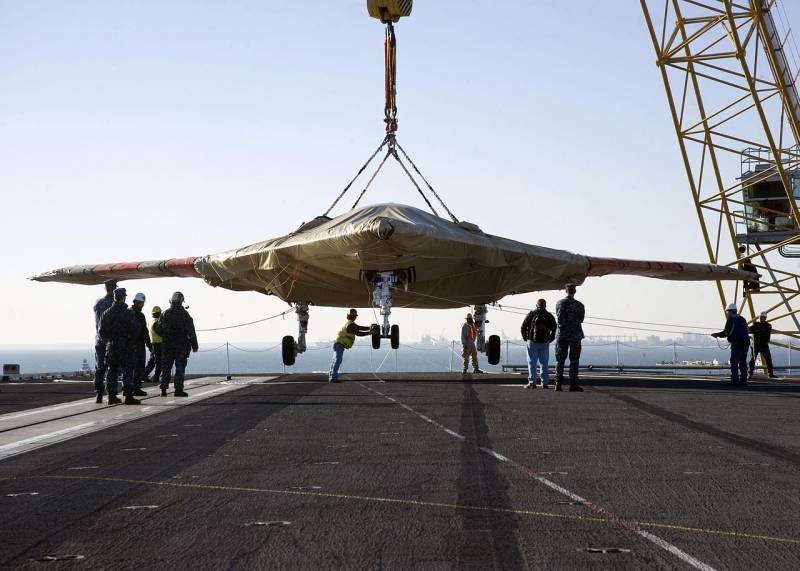
Experienced UAV X-47B at the beginning of testing on an aircraft carrier, November 2012
According to S. Tedford, plans for the development of unmanned systems should be drawn up taking into account the real situation and needs. He cited in-flight refueling as an example. The rear admiral suggested that some participants in the conference during the years of flight service had to look for a tanker aircraft at night and dock with it. In such a situation, autonomous control could be useful - in this case, the pilot's task will only be to approach the "tanker", and the automation will do the rest.
Of great importance, according to the program manager, is the architecture of systems. It is necessary to develop open systems that can show sufficient flexibility. The unmanned complex should be able to quickly prepare and adjust for a particular mission by replacing hardware or software modules. Such training, with its ideal implementation, was compared by S. Tedford with the installation and removal of applications on a smartphone.
Rear Admiral also pointed out an interesting feature of unmanned systems. So, a person is absent only on board an aircraft, while a lot of specialists are involved in its operation. In this respect, unmanned systems are similar to "ordinary" aviation. Accordingly, we are talking about a direct connection between manned and unmanned aircraft.
Experience
The US Navy has long been engaged in the topic of UAVs for naval aviation and is developing various projects of this kind. In the course of various experiments with various types of equipment, they managed to gain a lot of experience, on the basis of which they now plan to create projects of full-fledged complexes for real operation.
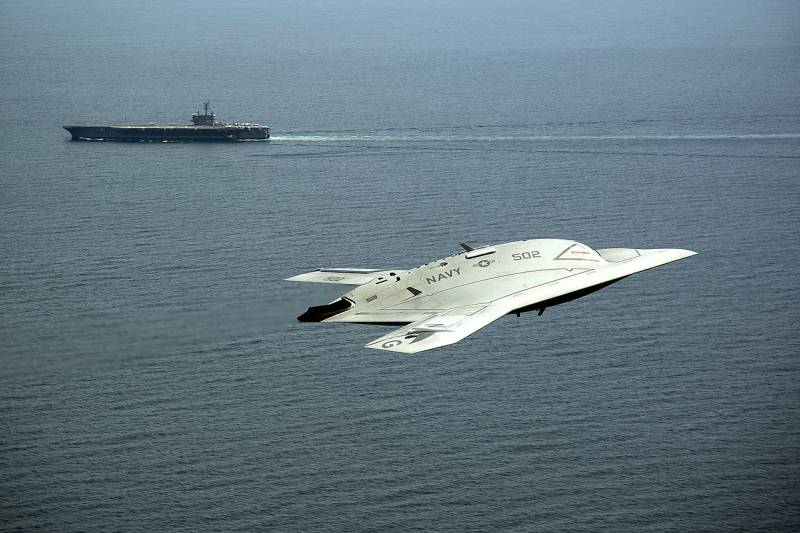
X-47B in flight
Northrop Grumman's X-47B was the first full-size UAV for the Navy to undergo lengthy and comprehensive testing. It was developed in the 2011s, and at the end of the decade the first prototype was built. In February XNUMX, the first flight from the airfield took place, and later tests began on board aircraft carriers.
Over the next few years, two prototypes flew from the deck and solved a variety of tasks. In 2015-16 all test objectives were achieved. UAVs demonstrated both their own capabilities and the prospects for the direction as a whole, after which the tests were stopped. Soon, two X-47B UAVs were used as flying laboratories as part of new projects.
The experience of the X-47B project is used to create new unmanned systems. For example, Boeing, commissioned by the Navy, developed the MQ-25 Stingray UAV. Externally and in function, it differs from the previous X-47B. At the same time, almost the same key technologies are used in the field of control systems, etc. Based on the experience of working on the X-47B, the scope of the new MQ-25 was also determined. It is considered as a specialized refueling drone.
The development of the MQ-25 was completed in the second half of the tenth years, and in September 2019 the first flight took place. Testing of the apparatus has not yet been completed. During test flights, the main flight performance was confirmed and the ability of autonomous operation was shown. Automated refueling is also being tested and compatibility with Navy equipment is being tested.
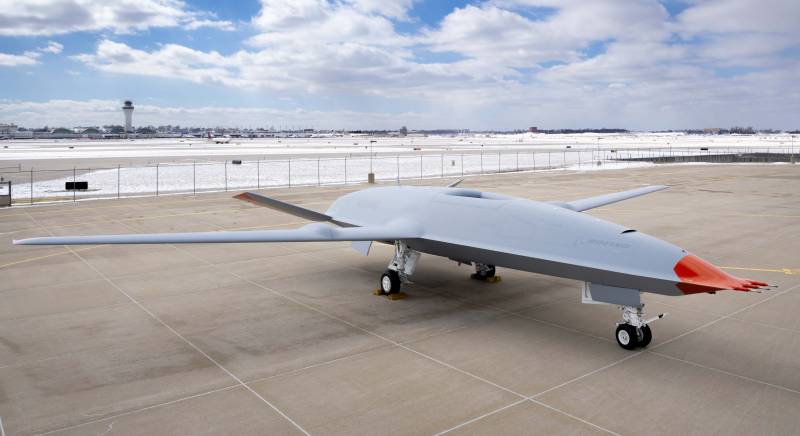
MQ-25 unmanned tanker
According to existing plans, testing and improvement of the MQ-25 will continue for several more years. In 2026 or later, they plan to put it into service with naval aviation and begin mass production. UAVs of this type will replenish the aviation groups of aircraft carriers and provide refueling of manned aircraft. How long the transition to such "tankers" will be carried out has not yet been reported.
It has been repeatedly reported earlier that, based on developments on the X-47B, Northrop-Grumman is creating a similar X-47C UAV. It should be larger and heavier, which will increase the payload and increase performance. However, the development of such a UAV has not yet been completed, and the future of the project is in question. Perhaps its creation has already been abandoned.
Applications
Medium and heavy class UAVs can be used in various fields and solve a fairly wide range of tasks. In fact, they can at least supplement manned aircraft, and in some situations even replace it. Similar opportunities exist in the field of naval aviation. The US Navy understands this and is trying to use the available opportunities.
Initially, UAVs of the X-47B type were considered as reconnaissance aircraft with high flight characteristics. Such a device can carry an optical-electronic station, a radar or electronic intelligence equipment. In this case, even large and heavy pieces of equipment can be used, and the unmanned platform allows observation for a long time and at a great distance from the carrier ship.
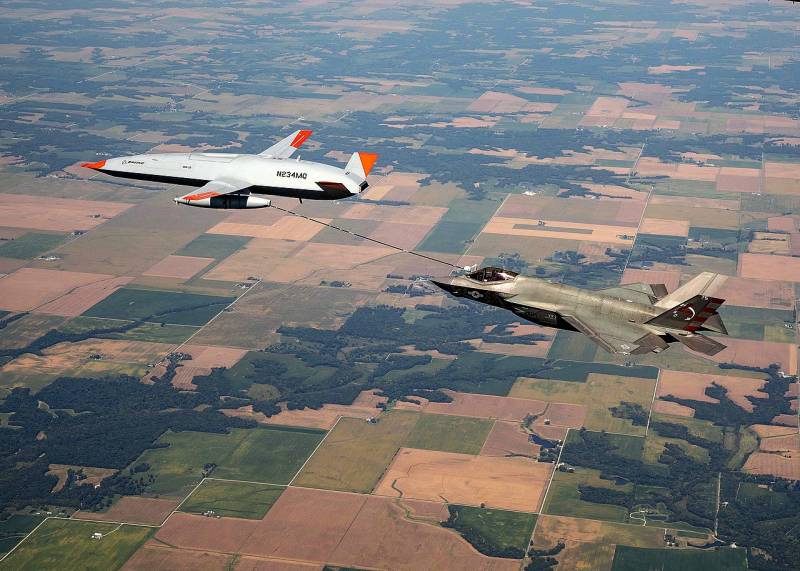
MQ-25 transfers fuel to F-35 fighter
However, based on the experience of testing the X-47B, it was decided to focus on projects for a different purpose. So, it was the existing UAVs from Northrop Grumman that were used in the first experiments with aerial refueling. Then these ideas initially formed the basis of the new MQ-25 project. Work on this drone continues, and in the medium term it will have to enter service.
The possibility of creating combat UAVs for the Navy is already being considered. Such ideas are mainly worked out in conjunction with the development of manned aviation. Thus, research and preliminary design of a promising carrier-based fighter-bomber, known as the F / A-XX, is underway. Within the framework of this program, the possibility of creating an unmanned version of the fighter is not ruled out. Whether such opportunities are used, and whether a combat drone for aircraft carriers will appear, time will tell.
It is possible that the Navy, in cooperation with the aviation industry, is also working on other areas for the development of UAVs for naval aviation. New ideas and projects of this kind are still hidden from the public, but they can be told about at any time and at any event. How this will change the overall picture of the development of US naval aviation is unknown.
Promising direction
The US Navy has long decided on its attitude towards unmanned aerial systems. They are considered useful and promising technology that can positively affect the capabilities and potential of the fleet. Moreover, experimental samples have already been developed and tested, and work has begun on equipment for future adoption and full operation.
In addition, the specialized structures of the Navy are already working on concepts for the further development of unmanned aircraft, studying the specifics of its interaction with manned aircraft and making plans for the future. In general, we are talking about a gradual increase in the number and role of drones in naval aviation, but so far there are no plans to abandon "ordinary" aircraft. Both in the medium and long term, a mixed air fleet will be built, and right now it is being decided what the shares of different equipment will be, and how roles and responsibilities will be divided between them.
Information